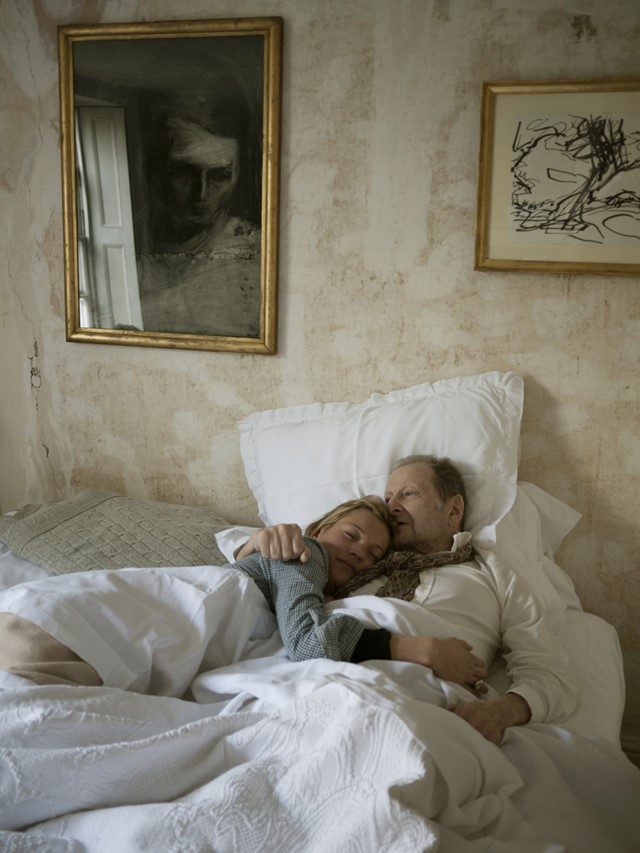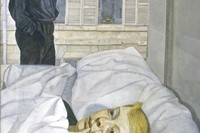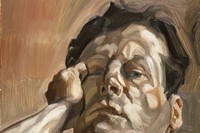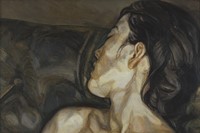To first enter the world of Lucian Freud is to become enveloped in a palette of overwrought flesh tones, where human skin is picked out in swirls of pink and white, blue and yellow, red, grey, black and brown...
To first enter the world of Lucian Freud is to become enveloped in a palette of overwrought flesh tones, where human skin is picked out in swirls of pink and white, blue and yellow, red, grey, black and brown. Faces are dizzying kaleidoscopes of vivid colouration, bodies lie brutally exposed in unmitigated nakedness, a pair of unexplained legs poke out from under a table. There is a sense of discomfiting weirdness; but then, as with a magic eye puzzle, one’s eyes get used to the style, and the purity and truth of the works become overwhelmingly apparent.
The National Portrait Gallery conceived this exhibition with the late artist himself back in 2006, so much of the structure and subject matter was organised with Freud’s approval. Laid out across a number of rooms in roughly chronological order, the 130-strong collection serves to document the development of his style from the strangely blank almond eyed figures of the 1940s, through the often painfully personal images of his lovers, wives, children and beloved mother, to the iconic largesse of the portraits of Leigh Bowery and “Big Sue” Tilley, ending with the poignancy of his last work, a picture of his assistant David Dawson with his whippet Eli, that was left unfinished on the easel at his death. Fashioning these images into a coherent whole has been the work of adept curation, with images working together to form a powerfully resonant story out of the fragments. The deeply intimate and peaceful Girl in Bed from 1952, which shows Freud’s second wife Lady Caroline Blackwood, is paired with the oppressive composition of Hotel Bedroom from 1954; a dual portrait of the artist and wife acting as a literal manifestation of the distance that has sprung up between them. Self-portraits by the artist are dotted through the show, reminders of the artist changing as a man in how he perceives himself, and also as an painter in how his art is practiced.
"There is a sense of discomfiting weirdness; but then, as with a magic eye puzzle, one’s eyes get used to the style, and the purity and truth of the works become overwhelmingly apparent"
Most fascinating of all, the exhibition allows insight into the mutating practices of an eternally engaged and experimental artist. As the icy clarity of his early works mutates into the vivid colour swirls and thick brush strokes of the later ones, as he eschews sitting knee-to-knee with his subjects to standing back at a distance, as he explores personalities that fascinate him and body shapes entirely unlike those usually positioned on modeling couches, the portraits take us through the evolution of an artist who constantly explored, innovated and advanced his practice throughout the seven working decades of his life.
Yet vitally, these are portraits, and for Freud, so much of the power of his work comes from the relationships he forged with the people he painted; indeed it is the strength of that understanding which makes these works sing. For some it could be an exhausting experience, as with Harry Diamond who sat three times for Freud, and said, “if someone is interested in getting your essence down on canvas, they are also drawing your essence out of you…” Long, slow days of sitting were common for Freud’s subjects, and in the bubble of his Holland Park studio where he moved in 1977, it is clear that firm bonds of trust and understanding were built up, both out of time shared and absolute necessity. Nowhere is this more apparent than in his nudes, which are works that investigate the human body without puerility or lasciviousness. Rather they are testament to Freud’s own obsession with the tapestry of skin, the life it radiates and what it shows about the person that it clothes.
Another element that has highlighted the relationship of Freud with his sitters is the photography of his assistant David Dawson, who worked with Freud for the last twenty years of his life. These images, currently on show in London and Chichester, are a fascinating glimpse into the working life of an extraordinary painter, and pay testament to the close relationship between artist and sitter.
Lucian Freud: Portraits is at the National Portrait Gallery until March 27. Lucian Freud: Studio Life is at Hazlitt Holland-Hibbert until March 2. David Dawson: Working with Lucian Freud is at Pallant House until May 20.
Text by Tish Wrigley



